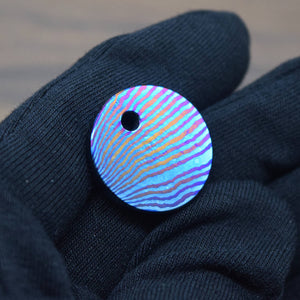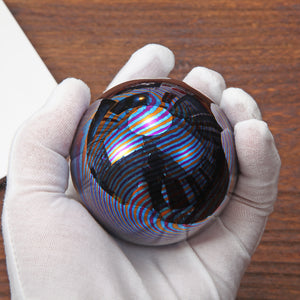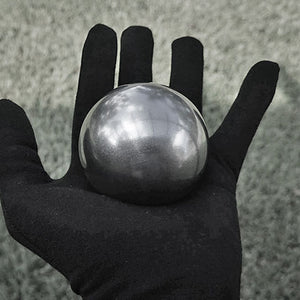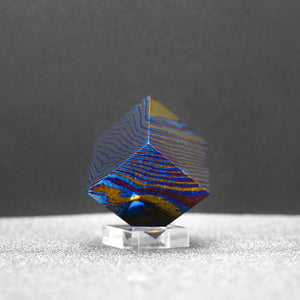ONE KILOGRAM PERFECT SILICON SPHERE
SOLD OUT
Our Quest for the Perfect Silicon Sphere

In the early 1990's a team of scientists from around the world began a project to redefine the kilogram standard of mass known as the International Avogadro Project. This resulted in the world's roundest object, a perfect sphere of crystalline Silicon. When we saw one of these $3.2 million dollar works of scientific art, we knew we needed to have one!
We wondered: Could we use our expertise in making perfect metallic spheres to create a silicon crystal sphere without spending millions of dollars?
The Trance Silicon Sphere: A Wild two year journey

Step 1: Finding the Right Crystal
We wondered - could we take an off-the-shelf single crystal of silicon and make our own sphere? We have made thousands of metal spheres in the past, but silicon was a metalloid (more below) and needs different tools to shape into a sphere.
The original kilogram prototype sphere was 93.75mm in diameter, but only consisted of silicon-28. A kilogram of silicon-28 goes for about $1.5 million, so we needed a more reasonable alternative. Our sphere would be off-the-shelf crystalline silicon used in making computer processor chips (thank you computer industry!). These mass-produced crystals have the following distribution of isotopes:

That means if we made the exact same size sphere, it would be heavy by about 0.39%.
The original sphere was 93.75 mm, with 2.15 x 10^25 atoms. Our sphere would need to be 0.39% smaller, which is 93.38 mm. Since the CNC lathe we wanted to use in the final process is accurate to about 0.01 mm, this is a significant difference in the input code.
We secured several kilograms of 100 mm silicon boule (lab-grown single crystal cylinders) and got to work experimenting!
A Lesson in Stonework
First lesson, this is a LOT tougher to shape than metal. Each metal we've worked with has it's own unique characteristics, but this was a different beast entirely. A metal sphere can be shaped in an hour in some cases. This is what our first attempt looked like after an hour of cutting:

Since Silicon is a metalloid and has some similar properties to stone, we decided to use some stone-working techniques to get the basic shape.
Eventually, we got a sphere:

Our first few prototypes make smooth-to-the-touch spheres, but they were quite dull. It took many tries to choose the right cutting blade and get the smoothness right. Choosing the right kind of material for the cutting blade was critical.

We initially used stone-polishing processes used for making decorative granite spheres. That gave us the shiny surface we were looking for, but it still didn't rival the finish the scientists were getting with their $3.2 million dollar spheres. We weren't happy yet!

We altered the process somewhat and increased the polishing time to three days(!). We were definitely getting closer to the desired results:

This series of prototypes was shiny, similar to what you'd find with polished granite. However, it didn't quite meet our standard that we use to judge our metal spheres, so we kept trying to improve the finish.
Finally, a Breakthrough!
After months of struggling to improve the stone polishing process, we had an insight. The scientists who made the original sphere used a lens grinding factory in their final polishing step. We always assumed this would be much too expensive, but after some research we realized it might be the solution we were looking for.
We found a factory that specializes in making custom lenses for the aerospace industry. They were willing polish one of our prototypes. Everyone was shocked at the result.

These look so incredible with a breathtaking luster you have to see to believe.


Ok, why doesn't it cost $3.2 million like the original?
The original sphere used an extremely rare single-isotope crystal of Silicon-28. The material itself cost $1.5 million, while off-the-shelf silicon crystal is a commodity item for the chip-making industry and can be had in the $100's of dollars range. The other huge contributing factor is the accuracy with which the scientists were trying to achieve.
They literally made the roundest object in the world after weeks of polishing in a lens-maker laboratory. They wanted an accuracy of +/- 0.0000002 grams. This is impossible with any off-the-shelf solution and required constant laser measurements. So far, our accuracy is about +/- 5 grams, which isn't usable as a mass standard, but perfectly wondrous as a beautiful heirloom piece.
What is Silicon?

Silicon is a metalloid. It is one of the few elements that are not metals or nonmetals. It has an atomic number of 14. It its crystalline form, it is a dark shiny grey with a luminous undertone. It is also a semiconductor. It is able to act as either a conductor or a non-conductor. This has lead to its widespread use in electronics.
What makes Silicon special?
Silicon makes up about 25% of our natural world. However, it is never found in its pure state. To get pure silicon, it must be carefully refined.
For those of you interested in a more affordable sample of Silicon, we're offering a salvaged shard of pure Silicon in our InvisiDisplay™ case:

Specifications

- 99.9999999% pure single-crystal silicon
- 2.15x10^25 atoms of Silicon
- 93.75mm diameter
- 1 Kilogram (+/- 10 grams)
Who is Trance Metals?
Trance Metals is a Texas-based company that specializes in aerospace-grade spheres. Our Copper & Titanium spheres project raised over $500,000 here on Kickstarter! Since 2015, we've produced over 30,000 aerospace polished metal spheres in Copper, Titanium, Tungsten and other metals.

We are the first company in the world to mass-produce mirror quality spheres in Copper and Titanium. We’ve learned just about everything there is to know about manufacturing the highest quality metal spheres.
We raised over $50,000 on Kickstarter to bring this silicon sphere to life. Get yours now!
Embracing small joys
Each item is designed to blend harmoniously with your living space while adding a unique touch. We aspire to bring balance and enrichment to everyday life.




